The Eggcellent Adventures of Marijke De Roover Part 1: A Womb of One’s Own
Marijke de Roover
- Presented by — Arcade
- Marijke De Roover, The Eggcellent Adventures of Marijke De Roover Part 1: A Womb of One’s Own, 2018, performance for Arcade, Performance Exchange 2022. Image: Damian Griffiths
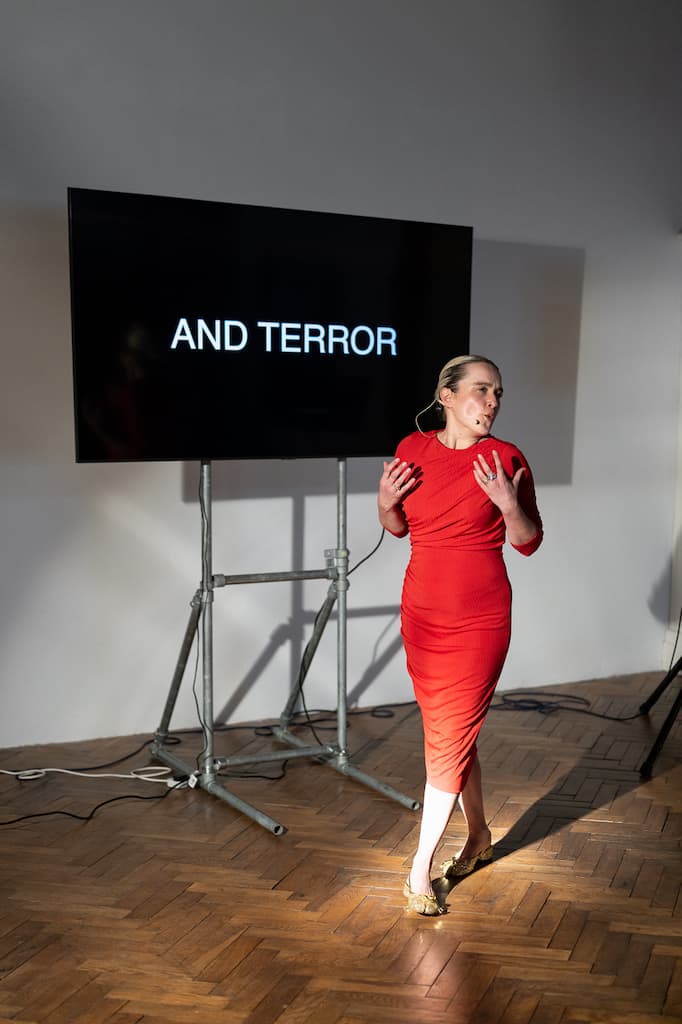
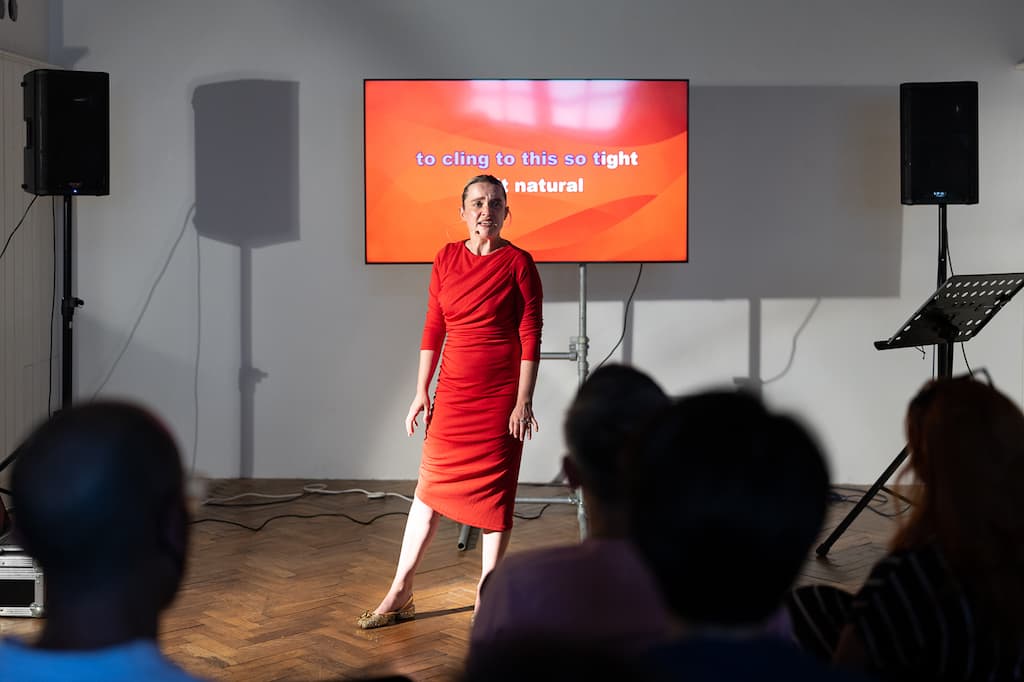
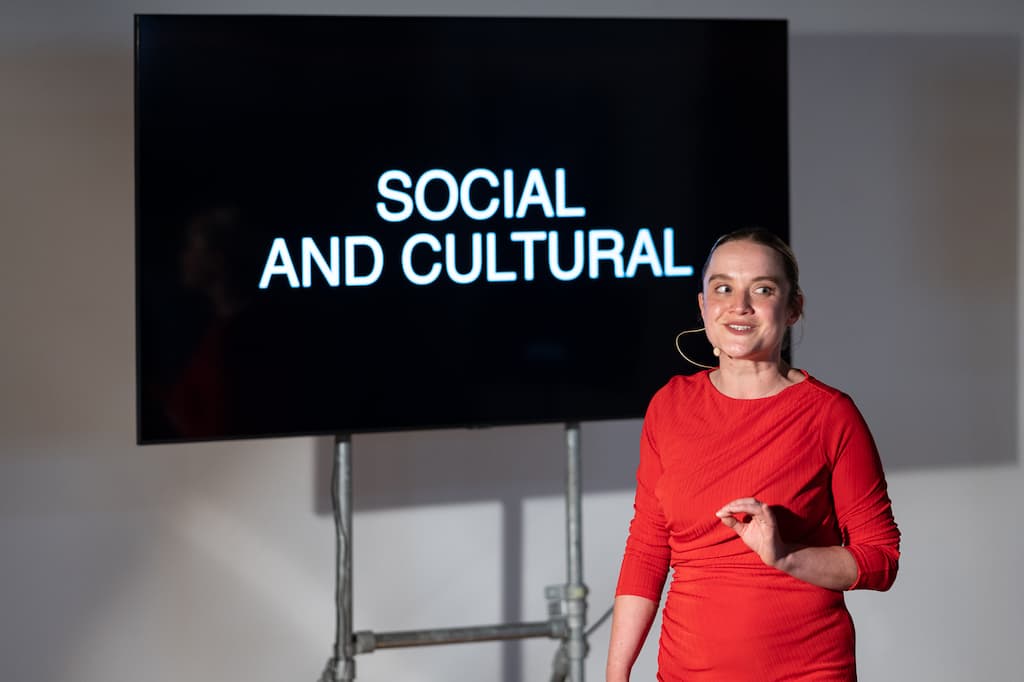
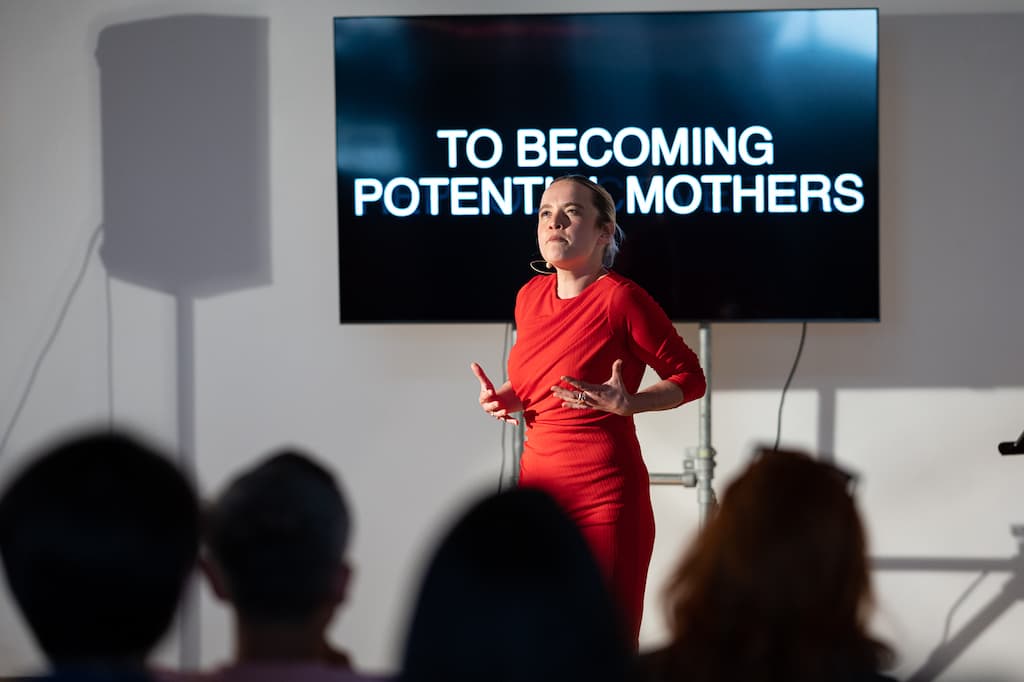

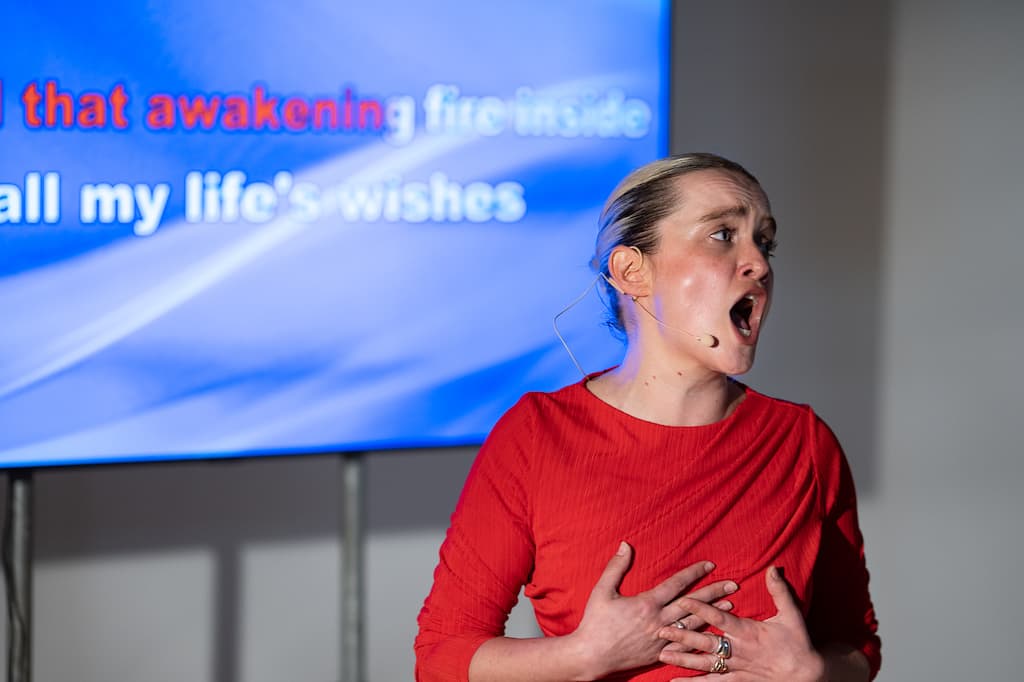

In her musical TED talk The Eggcellent Adventures of Marijke De Roover / Part 1: A Womb of One’s Own De Roover deals with questions regarding the nuclear family, feminism/motherhood and ethics of reproduction. TEDx (Technology, Entertainment and Design) talks address a wide range of topics often through storytelling. The speakers are given a maximum of 18 minutes to present their ideas in the most innovative and engaging ways possible. In 2010, noted statistician Nassim Taleb called TED a ‘monstrosity that turns scientists and thinkers into low-level entertainers, like circus performers’. De Roover chooses this format for her musical lecture performance to combine (pseudo-)scientific research, personal experience, including music and musical theater features intended to evoke emotional reactions of the audience, reflect on personal setbacks, and — through including fairytale inspired songs - to create a myth of origin of conceiving and raising a baby in a non-heteronormative family, often including questions of how the kids will relate to their family construction and existing tales and models.
A young woman stands on stage, oozing vitality. Her composure is confident, her gaze open to the audience, her attitude: here to make a statement. Marijke De Roover brings us her eggcellent adventures. A tale of personal longing, culturally imposed standards, biological limitations and comfort in the virtual sphere.
Throughout her presentation, De Roover’s default stance seems reminiscent of confident Ted-talk speakers who take centre stage as the dedicated spokespeople for any kind of hot topic. Radiating self-claimed expertise on issues ranging from banalities to quests for the meaning of life, they navigate a keenly choreographed limbo between technology, entertainment and design. Scientific findings, societal issues and worldviews are reduced to 18 minute rhetorics, the many quirky puns (intended) glue the discourse together for easily distractible ears. Pulp facts.
However, as a lady clad in red, she addresses the audience through a handsfree microphone with vivid hand gestures. Her experience is brought as multi-facetted as it is lived: objectively stated with crystal clear historic and biological facts; flawlessly sung with vocal virtuoso, in disguise through low-res karaoke-versions of exhausted pop songs, as well as in recorded confessions with punky camp DIY-aesthetics. The artist tells us a story so inherently personal that we cannot but surrender to her captivating epos which soars through mind, heart and groins. The story of getting knocked up.
A Womb of One’s Own spreads out as a collage of diary-like contemplations. It is underwritten by a theoretical framework that spans feminism, queerness, evolutionary theory, gender politics, as well as the history of biology and scientific reproductive research. We follow De Roover as she and her female partner embark on the physically and morally challenging quest of conceiving a baby together. The story is brought like an endless stream of consciousness made up of various voices, each one proclaiming its truths, convictions and ethical dilemma’s. They speak, recite, sing and appear as projected text on a screen. For a given that seems to be so evident, De Roover meticulously dissects the personal and collective implications of what it takes for a woman to get pregnant. In doing so, she is guided by the Internet’s plural and vast, schizophrenic and unreliable but supportive monster-mind.
Take for instance social media, whose various manifestations are a portal to information, testimonies, opinions, activisms and encouragement in De Roover’s trajectory - as they are in her art and life at large. Subjected to tormentedly slow and demanding procedures of psychological enquiries; fertility diagnoses; sperm donor selection and IVF inception (not to mention the relational pressure that this imposes on the two lovers’ lives), she found a community of like-minded people online. They live, capture and share similar struggles on social media’s generic platforms, imbuing them with a sense of spectacle. In The Eggcellent Adventures, their voices fractiously mingle with those of the culturally imposed dogma’s on love and family that slap us in our face since the day we’re born: white, heteronormative and patriarchal. Together these form a conflicted and squabbling chorus, observing and commenting on the struggles of our young heroine on her path to reason.
Her thoughts and convictions flow like a violent cascade, including hopeful Disney-esque crescendo’s and defeated moments of silence. As the medical realities she faces prompt frustration and desperation, she tries to clear out her intuition. What does she want? Her inner compass is at all times distorted by her own thoughts, her own conditioning and her internalised peer-pressure. Though we do see a woman who is indeed an expert. An expert on her own case, urgently revealing the insecurities and moral dilemma’s that go with wanting a child in the 21st century.
The combination of the performance’s plurality and the fast-paced rhythm mimics the incongruent intensity of life itself. As you get overwhelmed with the artist’s explosive energy and manifold references, your mind switches on, off and on again. You get blown away, emotionally stimulated, angry in alliance and touched by the relentless and nearly claustrophobic obsession to which the protagonist has succumbed. You shift from tapping into personal memories on how these issues relate to your own life cycle, to recognising the widespread — and often unspoken — resonance of this plight: to have a womb of one’s one.
— Evelyn Simons
History of the Performance
The Eggcellent Adventures / Part 1: A Womb of One’s Own was created in 2018 as part of Rites of Exchange, a performative lecture program, curated by Curatorial Studies, KASK, Ghent, May 12, 2018 at ISELP, Brussels.
The performance was commissioned by curator Romuald Demidenko.
After the initial performance at ISELP, The Eggcellent Adventures was performed at ao. Brakke Grond, Amsterdam (NL), WORM, Rotterdam (NL), A Performance Affair, Brussels (BE), Point Ephemere, Paris (FR), Maison d’Art Bernard Anthonioz, Nogent-sur-Marne (FR) and Arco Madrid (ES).
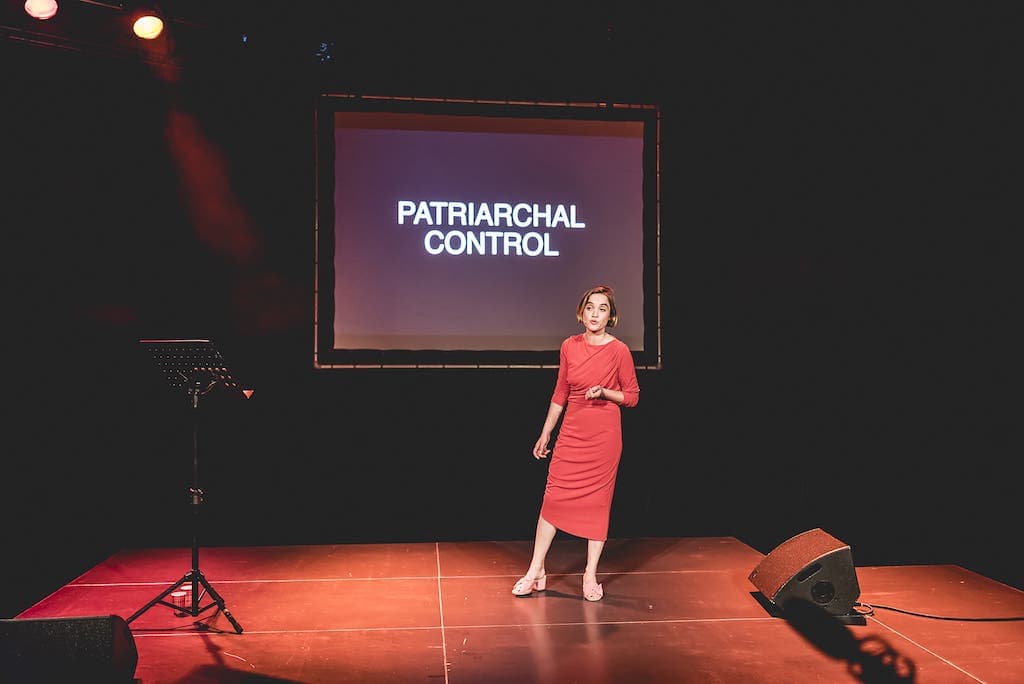
Conditions
The work can only be performed by a fertile, queer, young woman. As long as the artist belongs to this category, no one else can perform it. The artist will be in charge of selecting a new performer when the time comes, through the process of a reality/talent show. Although the setting of the performance is flexible, the script has to be followed at all times. The accompanying video is the guideline and the exact timeline for the performance. The institution is responsible for making professional documentation of the performance, both in video as in photography.
- Live performance: executed by the artist (creator and copyright holder of the pieces): Marijke De Roover (musical monologue, singing, video with instrumental soundtrack).
Duration: 22:00 min. - Space conditions: the space is a dark space with a stage or indication of stage. The wall colour is neutral. The space is divided in two sections.
- The first one is the artist space (stage) and the other is a public area, where spectators can stand or sit. The performer is lit by two spots.
Script
THE EGGCELLENT ADVENTURES OF MARIJKE DE ROOVER
PART 1: A WOMB OF ONE’S OWN
The enclosed and secret room has been a potent image in women’s novels since Jane Eyre, but by the end of the century it came to be identified with the womb and female conflict… The secret room, the attic hideaway, the suffragette cell came to stand for a seperate world, a flight from men and from adult sexuality.
INTRODUCTION
Remember when the world became an itch for a deeper level? When a lot of us started to get the sense that almost everything around us was a laminated parody trying to appeal to aesthetics and terror and assumed ignorance? When the world became as much spin-induced apathy and the contagion of scary thoughts/abstract capital/winsome graphics as anything inter-galactic? When just switching between tabs on a laptop started to involve wading through multitude leagues of blubber between you and reality? When ‘reality’ appeared to be a viable alternative, somewhere out there, and not just an invention cooked up in a vat of desperately hopeful psyches?
It was then that I decided it was time to get knocked up.
(image)
SETTING
In the room
two women to womb a baby.
baby baby not on board (Yet?)
baby baby not boarding too late at gate D (you know what I mean)
We travel too much to make this work (she said)
STABILITY! RESPONSIBILITY!
And with a little voice I say: can the doctor see me now.
how will we afford to live?
(PAUSE FOR EFFECT)
When do you start thinking of yourself as a mother? Is it when you give birth, at conception or when your uterus starts making saltos whenever you see a two year old doing something SO DARN CUTE?
HIT ME BABY ONE MORE TIME
How can I explain the urge to grow a tiny human?
What is at the essence of this feeling of longing? Is it truly to raise a child, or is it another yearning I think a child will fill for me in my life?
It has long been esthablished that the deep feelings of wanting to have a child have their roots in a learned desire from strong, long-standing social and cultural pronatal influences — not biological ones.
Deciding to become a mother is thus a political choice. Not a natural given.
(yawn!)
The female body has been both territory and machine, virgin wilderness to be exploited and assembly-line turning out life. We need to imagine a world in which every woman is the presiding genius of her own body. In such a world women will truly create new life, bringing forth not only children (if and as we choose) but the visions, and the thinking, necessary to sustain, console, and alter human existence—a new relationship to the universe. Sexuality, politics, intelligence, power, motherhood, work, community, intimacy will develop new meanings; thinking itself will be transformed. This is where we have to begin.
HANG IN THERE. HANG IN THERE
(Mothers want to shoot me when I say I want to change the world, one diaper at a time)
(Men want to sleep with me so they can GIFT me life and meaning)
In a matter of a few decades, non-heterosexual females have gone from being cast as barren, sexual deviants, even monsters who were destined to dwell outside kinship logics and reproductive time, to becoming (potential) mothers bestowed with the trust of raising future generations.
Given the history of how feminine sexual deviances, such as sleeping with women, engaging in commercial sex, or being unmarried were grounds for losing maternal rights, jobs, and for overall stigmatization, this is quite extraordinary.
BECOMING FERTILE, a process that involves a desire to reproduce through pregnancy, is a rather queer phenomenon; it is profoundly shaped by effects of and access to fertility medicine itself. (DRUGS) The association of femininity with reproduction, including (but not limited to) pregnancy, breastfeeding, mothering, and fertility is a cultural fetish, and the question is, how do lesbian and other queer forms of engagement with reproduction challenge and reproduce such a notion?
SEE / SAW / SEED
poor little thing life is crazy and who even has time for sex. not me
Assisted conception such as IVF, which enables lesbian couples and single women to conceive, for example, can be understood as reducing rather than increasing patriarchal control over women’s reproduction.
Early feminist studies further identified ‘women’ in the process of reproduction as the body which reproductive technologies act on and change, that is, ??THE PREGNANT BODY??. Women who occupy other positions in the reproductive processes, for example women who experience conception from the position of being the partner of a pregnant woman, are unrecognized. I do not wish to imply that the bodily experience of a woman undergoing fertility treatment or pregnancy is the same as a partner who supports her through the process; however, the equating of ‘woman’ with ‘pregnant woman’ is heterosexually normative. It obscures a central feature of lesbian couples’ reproduction: a woman may take part in the process and experience of reproduction without being pregnant.
(image)
Meanwhile, the techniques that control heterosexual reproduction have been increasingly externalized in recent decades. First, the (female) pill separated heterosexuality from reproduction, rendering obsolete the rationale that originally justified the hetero- versus homosexual schematic as an opposition between normal reproductive and pathological nonreproductive sexualities. Second, with the advent of in vitro fertilization, sexual recombination began to take place outside the body. Soon, the industrialization of the external womb will make the archaic distinction between masculinity and femininity obsolete, too.
The term ‘heteronormativity’ has developed within studies of sexualities to denote how heterosexuality is produced as the normal sexual practice. Prevailing norms of heterosexuality can be understood as operating on multiple social levels. The concept of heteronormativity does not encompass the full complexity of different social dimensions of heterosexuality. I use ‘heteronormativity’ to describe the way in which heterosexuality is normatively constructed, both socially and culturally. The term ‘heterosexual imaginary’ was developed as a critique of unacknowledged and under-theorized heterosexuality in feminist sociology. Ingraham’s ‘heterosexual imaginary’ refers to the way in which heterosexuality is normalized, and hence is considered to require neither exploration nor explanation. While gender has been deconstructed and analysed as a social construct in feminist sociology, heterosexuality remains ‘the normal’. Ingraham states: The heterosexual imaginary is that way of thinking which conceals the operation of heterosexuality in structuring gender and closes off any critical analysis of heterosexuality as an organizing institution. The effect of this depiction is that heterosexuality circulates as taken for granted, naturally occurring, and unquestioned, while gender is understood as socially constructed and central to the organization of everyday life.
It is clear that the heteronormative ideal of gender equality revolves around the ‘problem’ that pregnancy and motherhood pose to equality between men and women in the labour market as well as the home also shapes understandings of equality in same-sex families. The overarching argument for equality is that biology both does and does not matter; it might be important in the forming of kinship but not in the forming of care. Both heteronormative gender equality and lesbian mother/parenthood, I contend, thus require the downplaying of the ‘difference’ that pregnancy poses. However, the idea that a lesbian family consists of two mothers, that is, two women who potentially fill and thus compete for the same position of motherhood, is not as rosy as one might imagine, it can raise a particular set of affective charges and dilemmas.
When the idea of same-sex motherhood rests on an idea of gendered sameness, ‘becoming fertile’ means that lesbians and other queer women are drawn into a heteronormative discourse in which the position of mother remains singular and thus must be shared equally.
I would argue that an ideology of gender equality that departs from an unmarked white, middle-class nuclear family logic inevitably leads to an idea of parental equality that requires sameness, or the absence of difference. Among lesbians the difference that fertility–pregnancy–gestational motherhood makes is understood as problematic primarily when it risks undermining the status of the other parent, or when it results in a division of labour that can mimic that of heteronormativity and women’s subordination in a heterosexist world.
(PAUSE)
(little shrug, maybe crying)
Now the results are in, what am I going to do with myself? Now I am all out of spark. Just when now is the time – for greatness, for breaking out, for change. I put my hands on my belly. EMPTY. Baby?
Too little future / too much future.
Sometimes a catastrophe bleeds life.
ALSO
how to fluidly move from spoken text to song?
I’m no fucking Stephen Sondheim.
(moving to song now)
(image)
Collectables
-
The work will be publicly performed at the hosting institution by the artist
-
A video will be produced that integrates the photographic elements with documentation footage of the performance executed in the hosting institution
- Live in Concert Footage: Original Source Files and Master Edit on Hard Drive
- script + sheet music
- a karaoke package of the performance songs
- a press package including high resolution images chosen for this package
Equipment
- DPA 4088 cardioid headband microphone, nude + wireless transmitter
- High quality stereo speaker, neutral looking, black
- Mixing panel
- Hanging projector
- Media player with usb input
- All necessary cabling
- Electrical points (power outlets)
- Two hanging spots, white light, slightly dimmed
- Seats for the public
- Technical assistance as required